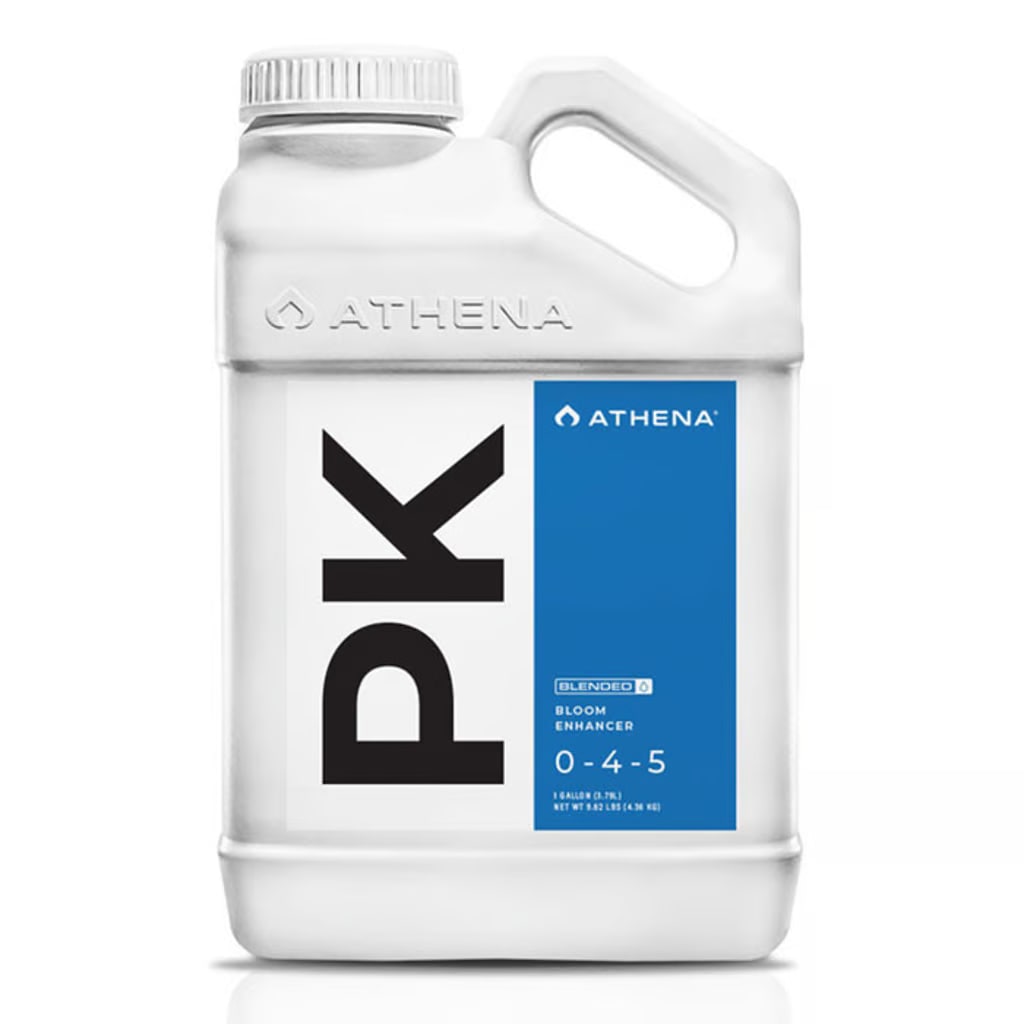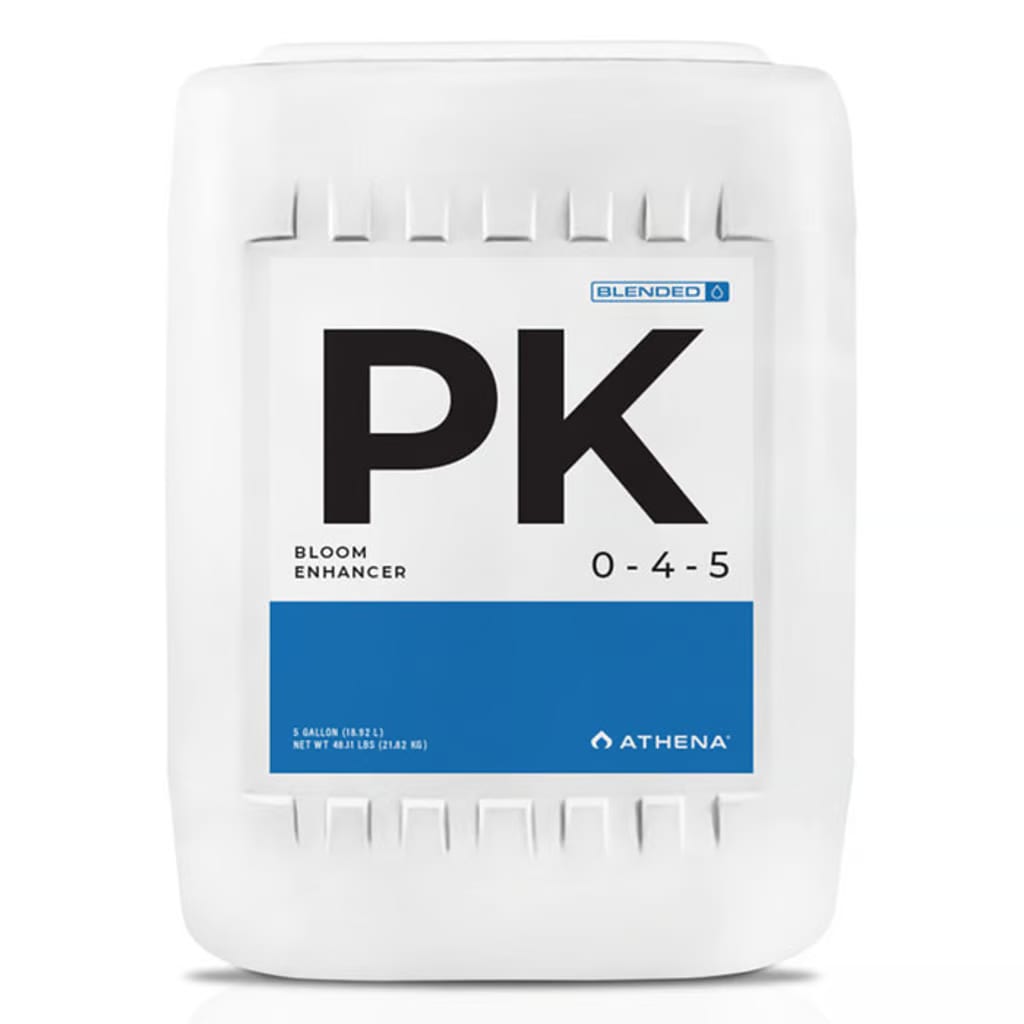Athena
Athena Blended PK 0-4-5
Athena Blended PK 0-4-5
45 in stock
Couldn't load pickup availability
Payment options
- Fast Delivery
- Easy Returns
- Secure Checkout
Description
Description
Athena PK is a powerful bloom booster and phosphorus-potassium supplement designed to maximize flower development and fruit production in plants. This specialized formula provides essential nutrients to enhance blooming and increase yields, making it an ideal choice for growers aiming to achieve abundant, high-quality harvests.
Key Features:
Bloom Enhancement: Athena PK is engineered to specifically support the flowering and fruiting stages of plants. It stimulates prolific flower formation and development, resulting in larger, denser, and more vibrant blooms.
High PK Content: With a high phosphorus (P) and potassium (K) content, Athena PK delivers the crucial nutrients that plants need during the flowering phase. The NPK ratio is tailored to maximize flowering and fruiting without promoting excessive vegetative growth.
Increased Yields: When used as directed, Athena PK can significantly boost yields. It encourages plants to produce more fruits or flowers, ultimately leading to a more productive and rewarding harvest.
Potassium for Stress Tolerance: Potassium plays a crucial role in plant stress tolerance, helping plants withstand adverse environmental conditions, pests, and diseases. Athena PK's potassium content contributes to overall plant health.
Minimized Nutrient Waste: This nutrient is carefully formulated to be easily absorbed by plants, minimizing the risk of nutrient runoff and waste. It's designed for efficient nutrient utilization.
Use with Base Nutrients: Athena PK is a bloom enhancer and should be used alongside a balanced base nutrient regimen. It complements the primary nutrients supplied by base nutrients, optimizing the overall nutrient profile for flowering plants.
Compatibility: It can be integrated into various cultivation systems, including soil, hydroponics, and other growing mediums.
Customizable Dosage: Growers have the flexibility to adjust the dosage to meet the specific needs of their plants, allowing for fine-tuning of the nutrient regimen.
Usage Instructions:
Mixing: Dissolve the recommended amount of Athena PK in water, following the instructions provided on the product label. Ensure thorough mixing for a homogenous nutrient solution.
Application: Add the prepared nutrient solution to your plants' growing medium, ensuring even distribution to maximize flower sites.
Feeding Schedule: Athena PK is used during the flowering phase of plant development. Incorporate it into your regular feeding regimen to maximize flower and fruit production.
Monitoring: Observe your plants for robust blooming, larger flowers or fruits, and signs of enhanced flowering. Adjust the nutrient dosage if necessary based on your observations and specific plant needs.
Consistency: Maintain a consistent feeding schedule to support flowering and achieve the best results. Continue to use your base nutrients in conjunction with Athena PK.
Athena PK is an indispensable tool for growers who aim to enhance flowering and significantly increase yields in a wide range of plants. By providing the necessary nutrients to support blooming and fruiting, this product can help you achieve healthier, more productive, and visually striking harvests. Whether you're growing flowering ornamentals, fruiting vegetables, or any other blooming plants, Athena PK can be your key to achieving impressive results.
Athena PK is a balanced bloom boosting complement to our Bloom fertilizers. This clean liquid booster is designed to supplement during the mid- to late-flowering phase. Athena PK is a low Nitrogen booster that provides additional Phosphorus and Potassium that high-yielding plants require for maximal production. Many PK boosters add far too much of these elements and create a cascade of problems, such as reducing Calcium and Magnesium availability. Balanced elemental bioavailability is essential in the flowering phase to boost essential oil and terpene production.
Application Rates:
Add 3-10 mL per gallon of water during the flowering phase starting in week 3. See Feed Schedules for specific application recommendations.
Best Practices
Use clean measuring instruments--do not put anything into the bottle.
Monitor EC regularly and adjust accordingly based on the crop and growth stage.
Adjust pH to proper levels after mixing all fertilizers and additives.
Store closed in original packaging at a temperature between 45° F and 85° F.
Share


INFORMATION QUESTIONS
FREQUENTLY ASKED QUESTIONS
What is Hydroponics?
Hydroponics is the science of growing plants without soil. The plants thrive on the nutrient-water solution alone. The growing medium merely acts as a support for the plants and their root systems while the solution passes freely. The growing medium, if any, is totally inert.
What types of plants grow best hydroponically?
Anything can be grown hydroponically, but some plants prove to be more space efficient. Some plants we suggest are tomatoes, sweet peppers, hot chilies, lettuce, spinach, squash, cucumbers, broccoli, beans, snow peas, herbs and flowers of all types.
Can you REALLY get better yields/quicker growth?
Absolutely. The plants, when receiving everything they need, tend to be healthier, faster growing and generally more productive. You can expect 30% faster growth with many crops.
What are the watering cycle timelines hydroponic systems?
Once the reservoir is filled with nutrients, it is time to put your hydro system to work! The ease of hydroponics is automation – automation is achieved by putting the pump on a timer according to your watering needs. The watering cycle depends on growth stage, growing medium and hydroponic system. In an ebb and flow or drip system with rockwool as the medium, seedlings, clones and plants in the early vegetative stage require watering only once a day for 15-30 minutes (twice a day for higher temps). Mature, flowering and fruiting plants require a heavier feed and can be fed once a day for 30 minutes (twice a day for higher temps). Typically soiless mixes and coco fiber can be watered for about 15 minutes twice a day, and can be adjusted for heavier feeding during the flowering and fruiting stage or higher temps. ViaStone, Hydroton, Grow Rocks, and Silicate mediums need to be watered more frequently – a constant drip for drip systems, and about 15-30 minutes every 3 hours for ebb and flow systems and can be adjusted for heavier feeding during the flowering and fruiting stage or higher temps. Aeroponic systems require frequent watering cycles; 30-60 seconds every few minutes or a constant spray.
What do I need to test pH? How do I test pH?
pH has a range from 0 (acidic) – 14 (alkaline), with 7 being neutral. A proper hydroponic pH range is between 5.5 to 6.2 for most hydroponic crops. For specific crop pH, check out our Plant Guide. pH must remain within the proper range for good plant health, disease resistance, and proper nutrient uptake. pH is maintained by adding pH Up and pH Down to the nutrient solution. For more information, see the Testssection of our site.
How will the flavor compare to my outdoor grown, organic produce?
The taste may be even better! This is simply due to the fact that the hydroponically grown plants are getting everything they need, when they need it. Don’t be fooled by “hot house” produce grown commercially. The grower’s primary concern is shipability and storage, not flavor. When you grow your own vegetables at home, you can expect nothing less than excellent results. Plus, hydroponically grown produce has the added benefit of a longer shelf life.

